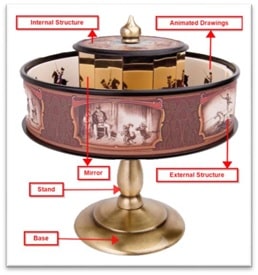MTD311 Interactive Digital Animation
Question 1
Part 1
Consider French animator Emile Reynaud’s Praxinoscope of 1877. This historical device is part of a group of visual machines known as the ‘Camera-less Animation Devices’. In those days these are considered Novelty or fun items. The Praxinoscope uses mirrors to create the illusion of visual movement that our eyes see as ‘animation’ when rotated. There are many variation of the Praxinoscope – some are elegantly constructed and presented as decorative pieces in homes while others are created modestly, rather more operational than decorative. Whichever, their basic concept and operation are the same – a manually rotated drum or wheellike structure holding an equal number of images to an equal number of mirrors. When rotated, a stationary vantage point (from the viewer’s point of view) will see reflections of hand-drawn animated drawings creating the ‘Moving Images’ our minds ‘sees’. This phenomenon is possible as explained through the theory of the Persistence of Vision.

https://zoetropeanimation.com/products/praxinoscope-animation-toy-large
Using Blender 3D, create a simulation of the operation of the Praxinoscope. In the simulation you are to ensure the following is clearly shown and demonstrated.
- The Praxinoscope is displayed as a decorative piece on an elegant table or waist-height cabinet top.
- It can be rotated at a speed that would allow the animation drawings be seen as an animation.
- [ https://www.youtube.com/watch?v=xOItdZOGnx8 ]
- Provide a Vantage point (a camera view) where the actual animation is seen – the reflection from the mirror.
- Provide or create the animation drawings – 12.
- Provide the corresponding number of mirror surfaces (in Blender).
- Effective rotation speed to allow the simulation to work (seen) successfully. Effective lighting.
- Present the simulation in a duration (time) span that’s most effective – not too draggy or too fast.
Reference the following
- Model and construct the External Structure of the Praxinoscope with an appropriate Stand/Base with the relevant and appropriate texture mappings. The Animated Images are part of this structure. (20 marks)
- Model and construct the Internal Structure of the Praxinoscope where the corresponding Mirrors are housed and with the other relevant and appropriate texture mappings. Both the External and Internal structures can be freely rotated. (20 marks)
- Setup and use Key Frame animation to create the rotation of the Entire Praxinoscope. The Stand/Base should not be rotated and should be stable and firm. (20 marks)
- Setup and apply Effective Lighting for appealing illumination, creating good contrast and realistic shadows. (10 marks)
- Setup and use an Effective Camera Angle to observe the Praxinoscope as it rotates and also how the animation will appear as it is being rotated. (10 marks)
The Final Simulation should be produced with the following requirements:
- 600 x 450 pixels.
- Frames per Second: 25.
- File Output Format: MP4.
Part 2
Document and describe your production process in a Report using MS WORD. Include sufficient screenshots to aid your explanation achieving relevant balance between screenshots and words.
(20 marks)


